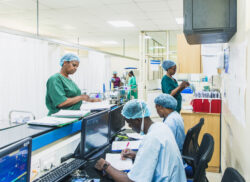
Universal Health Coverage (UHC) has gained traction globally, regionally and nationally in line with United Nations Sustainable Development Goals (SDGs) number 3, which aims to ensure ‘everyone has health coverage and access to safe and effective medicines and vaccines’ by 2030 (UNDP, 2015). The World Health Organisation (WHO) defines UHC as a health system where all people have access to the requisite health services such as prevention, promotion, treatment, rehabilitative and palliative care without the risk of financial hardship when paying for them. It is a comprehensive and efficient health system providing a wide range of health services with access to good quality services, medicines, technologies and health workers (Ranabhat, et al, 2018; World Health Organisation, 2019).
It is important that the available services are communicated and promoted to the general public together with clear information on healthful lifestyles to aid people in making educated choices (UNDP, 2019). UHC therefore does not mean free healthcare, as people will have to pay for it somehow through taxes and mandatory contributory schemes. The programme puts emphasis on ensuring social protection and cushioning the poorest populations from high health risks as a result of financial hardships.
The Government of Kenya guarantees UHC in the Constitution of 2010 under the Bill of Rights and the Kenya Vision 2030. The Constitution of Kenya 2010 provides in Chapter 4 Article 43 (10) that: every person has the right (a) to the highest attainable standard of health, which includes the right to healthcare services, including reproductive health care. Subsection (2) underlines the right to emergency medical treatment. Therefore there is clear evidence that UHC is anchored in law.
Through both in the Kenya Health Policy 2014-2030, and the Kenya National eHealth Policy 2016-2030, the government is committed to putting in place strategic interventions aimed at accelerating, achieving and maintaining UHC through increased and diversified financing options (Government of Kenya, 2016a). It is also worth noting that UHC has been adopted in the President’s Big Four Agenda, which include achieving: food security, affordable housing, manufacturing, and affordable healthcare for all by 2022.
According to the UNDP Human Development Report 2019, Kenya is ranked 147 with a Human Development Index (HDI) of 0.579. The HDI measures achievements in three dimensions of human development: a long and healthy life; education (being knowledgeable) and decent standard of living. The health dimension is measured by life expectancy at birth (in years), education dimension is assessed by mean expected years of schooling, and the standard of living is measured by the Gross National Income (GNI) per capita ( 2011PPP US$).
Kenya scored 66.3 years, 11.1 years and 3052 US$ in health, education and standard of living dimensions, respectively, (HDR, 2019). Life expectancy in Kenya is still low and it is anticipated that rehabilitation and expansion of healthcare facilities, coupled with provision of accessible and affordable health services, will positively improve the health outcomes. According to Ranabhat, et al, (2018), UHC can significantly improve life expectancy at birth (LEAB and health life expectancy.
In 2018, President Uhuru Kenyatta launched the pilot UHC programme to be implemented in four counties: Kisumu, Nyeri, Machakos and Isiolo. These counties were selected based on high prevalence of communicable and non-communicable diseases, high population density, high maternity mortality, and high incidence of road traffic injuries. The government also set aside Ksh3.9 billion for the four counties in the UHC pilot phase. Following the successful implementation of the one-year pilot UHC programme, governors of 45 counties, except for Nairobi and Mombasa, have signed a similar inter-governmental partnership between January 2020 and March 2020, which will be rolled out bearing in mind the lessons learnt from the pilot project.
